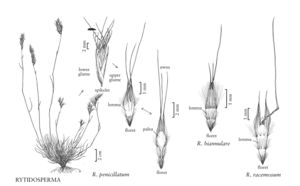Rytidosperma penicillatum
Plants loosely cespitose to somewhat spreading, shortly rhizomatous. Culms 30-90 cm, erect, mostly smooth and glabrous, scabrous-pubescent immediately below the inflores¬cence, branching extravaginal, the new shoots with scaly cata¬phylls. Leaves mostly basal, greatly exceeded by the culms, flag leaf-blades usually not reaching the inflorescence; sheaths densely hairy or glabrous, with apical tufts of hairs, apical hairs 1-3.5 mm; ligules 0.1-1 mm; blades to 30 cm long and 5 mm wide, flat, folded, or rolled, pubescent or glabrous. Inflorescences 4-10 cm, racemose or paniculate, contracted; pedicels much shorter than the spikelets. Spikelets 9-15 (18) mm, longer than the rachis internodes, with 5-10 florets; rachilla segments 0.2-0.5 mm. Glumes 8-14 (17.5) mm, subequal, lanceolate, some¬times with scattered hairs; lower glumes (5) 7-9 (11) -veined; upper glumes 5-7 (9) -veined; calluses 0.5-1.2 mm, longer than wide, with marginal tufts of hairs usu¬ally reaching the lower lemma hairs; lemma bodies (2) 2.5-4 mm, 9-veined, lower row of hairs continuous or with weak central tufts, hairs of the marginal tufts not or just reaching the upper row of hairs, upper row of hairs composed of 2 marginal tufts, sometimes with 2 additional scanty tufts between, hairs reaching or slightly exceeding the base of the awn; lobes 5-13 mm, aristate; awns (7) 9-16 mm; paleas 3-6 mm, exceeding the lemma sinuses, emarginate, intercostal region glabrous or scabrous, margins glabrous or sparsely long-hairy, veins ciliate; anthers 0.4-2.5 mm. Caryopses 1.8-2.5 (3) mm long, 0.8-1.1 (1.6) mm wide; embryos 0.7-1 (1.5) mm; hila 0.4-0.5 (0.7) mm. 2n = unknown.
Discussion
Rytidosperma penicillatum is endemic to Australia and has been introduced to New Zealand as well as North America. Although considered a poor quality forage, it was introduced and grown experimentally in several states under the name Danthonia pilosa R. Br. [= R. pilosa (R. Br.) Connor & Edgar]. It has become well-established in northern California and southwestern Oregon, mainly in coastal areas. Since it does well on dry, nutrient depleted soils and competes well with more desirable species, it is considered a troublesome pest.
Selected References
None.
Lower Taxa
"decumbent" is not a number.
